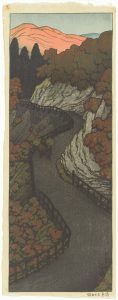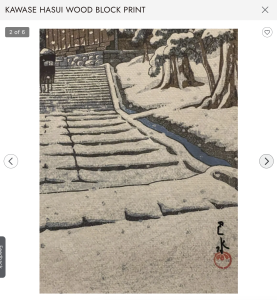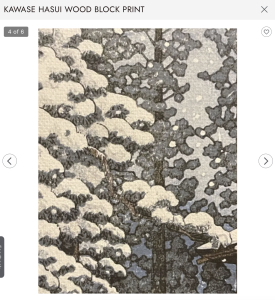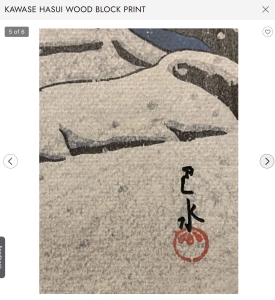The publisher Shozaburo Watanabe, upon the death of his long-time friend and creative partner Kawase Hasui, produced a small edition of no more than 100 impressions of “Hall of the Golden Hue, Hiraizumi” (1957), for distribution by Hasui’s widow at the celebration of the life of the artist, 100 days after his death (“Sokkoku-ki”). The print was made from the wood blocks (“hangi”) of a nondescript design originally published in 1935 that showed an empty pathway to the Chuson temple at night. See Image 1.
Watanabe remade the print into a poignant snowy Winter scene of a lone figure (Hasui) departing the frame, back to the viewer. The image of the departing figure beautifully bookmarks the end of a remarkably productive relationship that started with “The Okane Road, Shiobara” (1918), showing a lone traveler walking towards the viewer. See Image 2.
- Image 1 – The Golden Hall at Chuson-ji Temple in Hiraizumi
- Image 2 – The Okane Road, Shiobara
Only a handful of this final design survive, owing to the small printing size and unusual distribution process. This edition is distinguished by notations on the left margin which include a special seal reading “Zeppitsu” (final work), along with the title and date. See Image 3. Such first editions have sold at auction for $50,000 or more. A second edition of 350 prints was produced in 1979 upon the publication by Mainichi Communications of the Hasui catalogue raisonne by Narazaki. It has the same markings on the left margin but is distinguished by seals on the right reading “Hanmoto Ginza Watanabe Tadasu” (Watanabe Tadasu, publisher, Ginza), carver’s seal “Okura Hanbei” and printer’s seal “Horikawa Shozaburo,” as well as a limited edition stamp on the reverse with the publication date of 1979. See Image 4. Such second editions have sold at auction for $10,000 or more. Last, Shoichiro Watanabe, Tadasu’s son and Shozaburo’s grandson, produced a third edition after 1988, without the stamp on the reverse or the publisher’s, carver’s and printer’s information on the right margin, but with a red stamp on the right reading “Heisei.” See Image 5. Such Heisei editions have sold for $1000 or more. Unfortunately the high value of these prints has motivated opportunistic scammers, who prey on the complicated edition history and hopes of the gullible and uninformed.
- Image 3 – Hall of the Golden Hue, Hiraizumi (Original)
- Image 4 – Hall of the Golden Hue, Hiraizumi (Second Edition)
- Image 5 – Hall of the Golden Hue, Hiraizumi (Heisei)
These scammers have flooded the market with machine-made photo-mechanical reproductions (“giclee printings”), easily copied from high resolution images on the internet. An example of such a fake first state can be found here. The auction house incorrectly describes the print as a “Hasui Wood Block Print,” when in fact it is a worthless giclee copy made by a printing machine and not hand-printed from the original hand-carved blocks of wood. The giveaway is the textured pattern visible in the close ups – a telltale sign of a giclee printed on modern paper and not traditional Japanese paper with laid lines. The auction also strangely refers to “canvas size” in the description, as if the giclee was a painting. Finally, it reassures buyers that “no alterations noticed,” slyly suggesting alterations are possible, though unnoticed. The estimate of $1,500 to $3,500 also incorrectly signals to buyers the print is not a worthless copy.

Second states by Mainichi are also available from deceptive sellers. An example can be seen here. This auction is more polished, but the listing stands out for what it doesn’t say. It avoids describing the medium at all, even as a generic “print,” let alone a woodblock print. It fails to give the publication date of 1979, instead describing the date as “unknown.” The description ends with the words “Sold After,” a vague and meaningless phrase which could mean “sold after the original” or it could mean something else. The words are a fig leaf; an excuse to avoid saying in plain English the print is a copy and to allow the seller to blame the buyer for misinterpreting the description. The estimate of $400 to $800 also incorrectly signals to buyers the print is not a worthless copy.

Even worse than giclees are the adulterated Heisei edition works made to look like first editions. Here even the pretense of good faith ignorance is tossed out the window. An example can be found here. This scammer started with a genuine Heisei edition print. They scratched out the Heisei edition seal in the bottom right margin, then drew in by hand the Zeppitsu (final work) seal on the left margin. To complete the illusion, the scammer then scratched out the round Watanabe seal in the bottom left of the print and replaced it with a hand drawn seal in a slightly different position, to mimic its location in a first state. Shoichiro Watanabe identified nearly a dozen adulterated fakes that had been sold on Yahoo Japan for nearly $100,000, bringing to light the significant scope of the problem.
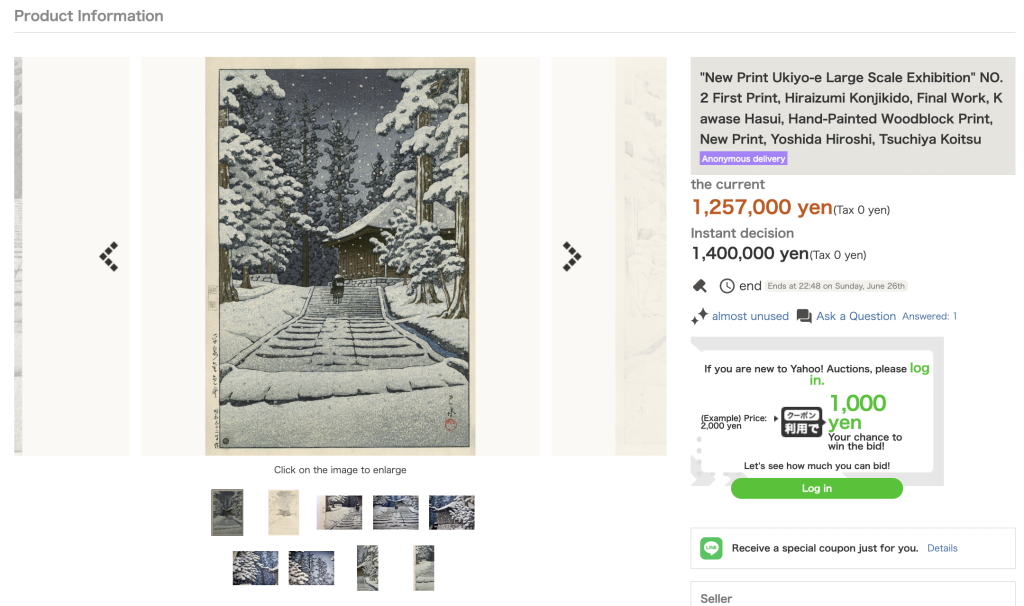
The best antidote to these scams is knowledge – about the print and the seller. We encourage you to study up on the different editions of this rare design and closely examine high resolution images of any you may be considering buying. Read the description with a critical eye and pay attention to what is concealed as much as what is revealed. You should have skepticism about deals that are too good to be true. They probably are. If you nonetheless remain perplexed, please reach out and we will be happy to help.
Bill Stein

